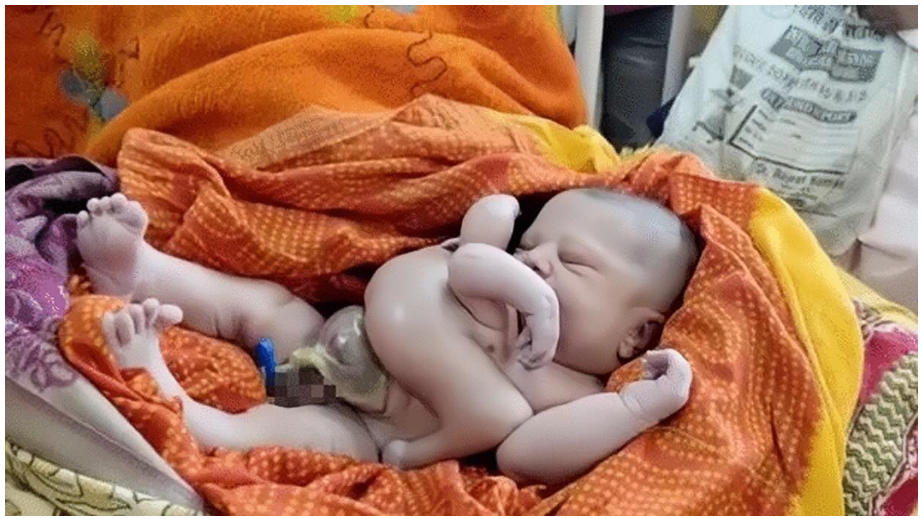Introduction
In a surprising medical revelation at Sarojini Naidu Children’s Hospital, Prayagraj, a small town in India, a seven-month-old boy was found to be carrying a fetus inside his stomach. This rare congenital anomaly, known as fetus in fetu (FIF), left doctors baffled and determined to save the infant’s life.
Fetus in Fetu (FIF)

Fetus in fetu malformation has been defined as the existence of a parasitic, monozygotic, diamniotic fetus in the body of its twin. Preceded by Willis in 1935, in 1954, Lord claimed the presence of a vertebral column and extremities and organs located at appropriate places around it as the basic diagnostic for FIF. These criteria are still, to a wide extent, valid today.1-6 However, some claim this pathology to be a well-differentiated and highly organized teratoma.7
FIF most frequently (80%) inhabits the retroperitoneal region. However, there have been few reports of FIF location in the head, sacrum, scrotum and mouth. Despite the requirement of the presence of a vertebral column for diagnosis, there are reports of cases without a vertebral column.4
It’s considered as a benign condition. Consequently, some researchers have stated that it is possible to leave some sections of the capsule in its place to facilitate the excision. Nevertheless, in one case, the mass has been reported to recur as a yolk sac tumour after 4 months. This has been attributed to the presence of immature tissues in the small areas and the remnants of the capsule of the mass.1
Complexity and Prevalence
FIF is an incredibly uncommon condition; it’s an anomaly that occurs when one twin develops inside the other twin’s womb, forming a fetus within the host child.
It occurs in about 1 in 500 000 live births; less than 200 cases have been reported in the medical literature.8
Understanding the Case
The child’s condition was critical in this particular case, with a bloated stomach and severe pain. The urgency prompted immediate action, and the child was admitted for further examination and treatment.
However, under the skilled hands of Dr D Kumar and his expert team, a complex surgery was performed to remove the developing fetus from the infant’s stomach. The operation, lasting four hours, successfully removed the fetal mass.
Following the surgery, the young boy’s health improved, and he is now under the close supervision of medical experts. The miraculous surgery saved his life and offered hope to his family.
Dr Kumar explained the rarity of FIF, shedding light on the unusual occurrence of one twin developing inside the other. The phenomenon remains a subject of fascination and intrigue within the medical community.
Diagnosis
It is a rare entity that typically presents as an abdominal mass is a rare entity that typically presents as an abdominal mass in infancy or early childhood. It can be diagnosed in the preoperative period. Complete excision of mass is curative and confirmatory. Though a rare entity, it should be considered as a differential diagnosis for a lump abdomen in infancy and early childhood.
Conclusion
The seven-month-old boy’s journey of miraculous survival serves as a reminder of the wonders of modern medicine and the relentless pursuit of saving lives, even in the face of the most extraordinary challenges.
As medical knowledge and technology continue to advance, stories like this offer hope for tackling even the most complex medical anomalies. The young boy’s resilience is a testament to the power of medical progress and human determination.
References
- Hopkins KL, Dickson PK, Ball TI, Ricketts RR, O’Shea PA, Abramowsky CR. Fetus-in-fetu with malignant recurrence. Journal of pediatric surgery. 1997 Oct 1;32(10):1476-9.
- Federici S, Prestipino M, Domenichelli V, Antonellini C, Sciutti R, Domini R. Fetus in fetu: report of an additional, well-developed case. Pediatric surgery international. 2001 Jul;17:483-5.
- Kumar AN, Chandak GR, Rajasekhar A, Reddy NC, Singh L. Fetus-in-fetu: a case report with molecular analysis. Journal of pediatric surgery. 1999 Apr 1;34(4):641-4.
- Hoeffel CC, Nguyen KQ, Phan HT, Truong NH, Nguyen TS, Tran TT, Fornes P. Fetus in fetu: a case report and literature review. Pediatrics. 2000 Jun 1;105(6):1335-44.
- Magnus KG, Millar AJ, Sinclair-Smith CC, Rode H. Intrahepatic fetus-in-fetu: a case report and review of the literature. Journal of pediatric surgery. 1999 Dec 1;34(12):1861-4.
- De Lagausie P, de Napoli Cocci S, Stempfle N, Truong QD, Vuillard E, Ferkadji L, Aigrain Y. Highly differentiated teratoma and fetus-in-fetu: a single pathology?. Journal of pediatric surgery. 1997 Jan 1;32(1):115-6.
- Heifetz SA, Alrabeeah A, Brown BS, Lau H. Fetus in fetu: a fetiform teratoma. Pediatric Pathology. 1988 Jan 1;8(2):215-26.
- Kumar A, Paswan SS, Kumar B, Kumar P. Fetus in fetu in an adult woman. BMJ Case Reports CP. 2019 Aug 1;12(8):e230835.




